When you want to buy a new or used guitar, you need to give it a comprehensive test to avoid buying a dud.
There is a lot to consider when testing a guitar you want to buy and in this guide, I’ll explain in detail everything to look for and to test.
In this guide, I’ll explain what to look for in electric and acoustic guitars, what to play when you test a guitar, and possible problems to look out for.
By the end of this guide, you’ll know exactly what you need to do to properly test a new or used guitar before you buy it.
Tip: make sure you have a thorough understanding of the parts of the guitar before reading this guide. Learn about all the parts of electric and acoustic guitars here.
If you’re looking at buying a used electric guitar, read this guide on where to look for used guitars, how to research the value of a used guitar, and how to negotiate a better price.
What to Look for When Testing a Guitar
Before I walk you through how to test a guitar, it’s important to understand the main areas you need to look for when testing a guitar.
Let’s quickly go through the main areas to look for when testing a guitar, then later in this guide I’ll give you a checklist you can use to make sure you cover all of these points properly.
Any time you test out a new or used guitar (electric or acoustic), you need to consider all of the below areas:
Look and Style
The look and style of a guitar are more important than many guitarists are willing to admit.
It doesn’t matter if the guitar you’re testing is the best sounding guitar in the world if you hate the look and style.
Take a look at the below guitar and think about whether it matches your personality and you would be happy performing to people with it:

For some people, the above guitar is perfect for them. For others, it’s hideous.
Key point: don’t buy a guitar that you don’t like the look and style of. It doesn’t matter if somebody says it’s a great guitar – what matters is if you like how it looks.
Comfort
If a guitar doesn’t feel comfortable to play, you’re not going to play it as often as a guitar that feels amazing to play.
While you should consider the look and style of a guitar, comfort is far more important because it directly impacts your enjoyment while playing.
Some guitars have ergonomic contours that hug your body as you sit down to play.
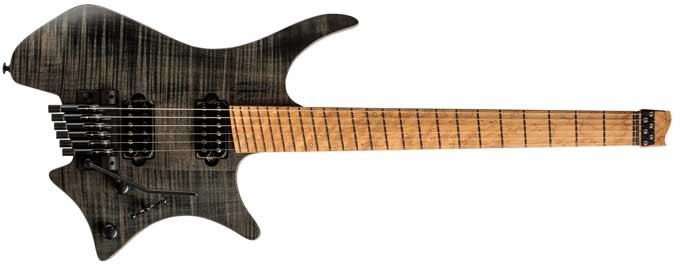
The above guitar is the most comfortable guitar I’ve ever played because it was designed with comfort in mind.
Other guitars feel horrible to play sitting down, but feel fine playing standing up.

You can’t play the above guitar sitting down in the standard position without using a strap. But it might feel completely comfortable playing standing up.
If you test out a guitar and it digs into your ribs, feels ridiculously heavy when playing standing up, or you notice any other comfort issues, take those seriously.
If anything bothers you during a short test, it’s going to get really annoying during any long play sessions.
Here are some areas to consider when testing a guitar for comfort:
- Does the guitar feel good sitting down?
- Does the guitar feel good standing up?
- Does the upper fret access feel cramped or comfortable?
- Does the neck profile suit your hands?
- Can you comfortably play what you normally play without issues?
- Does anything bother you (even slightly) while playing?
Some comfort issues can be due to a guitar feeling different than what you’re used to. Other issues are a sign that the guitar doesn’t suit you.
As an example, if you have small hands, a fat guitar neck can easily become a comfort issue. Read this guide on guitar for small hands to learn what to look for.
Action height also plays an important role in comfort. If you don’t know what this is, read this guide on action height to learn why it’s important and how to adjust it.

As the guide explains, every guitarist has a different preference when it comes to the ideal action height.
If you’re buying a used guitar, the action height may be set to suit the previous owner and not you. So don’t immediately dismiss a guitar due to action height.
Action height can be adjusted and unless there are problems with the guitar (covered later), you can always improve how a guitar feels to play after making proper adjustments.
Key point: if a guitar doesn’t feel comfortable, you’re not going to enjoy playing it as much. Test out a guitar in your preferred position (seated or standing) and think about how comfortable it feels to play.
Sound Quality
Whether you’re buying an acoustic or electric guitar, the sound quality of the guitar is crucial to consider.
Sound quality is highly subjective, so what sounds great to one guitarist may not sound great to another.
When testing an acoustic guitar, you want to play it as much as possible and really think about whether you’re happy with how it sounds.
There’s not much that can be done to change how an acoustic guitar sounds, so keep this in mind.
Keep in mind that the guitar strings will play a part in how a guitar sounds, so if the guitar you’re testing has an old set of strings, it’s going to sound warmer or duller than if it had a brand new set of strings.
When testing an electric guitar, go through all of the pickup positions, adjust the volume and tone knobs, and if possible, play through your own guitar amp.
While it’s possible to change the guitar’s pickups, factor this cost in and how much of an impact it could have on the guitar’s tone.
If you’re not happy with how a guitar sounds, consider whether it’s worth trying to improve or not. Is it worth changing pickups? Will changing the strings fix the issue? Or would you be stuck with how it sounds?
Key point: Don’t buy a guitar you don’t like the sound of. It doesn’t matter if somebody else says it’s an amazing guitar – you’re the one who has to listen to it.
Hardware Quality
If the guitar you’re testing looks good, feels good, and sounds good, the next area to consider is the quality of the hardware.
The quality of the hardware includes the guitar’s tuners, nut, frets, neck, bridge, pickup selector, knobs, and electronics.
You want to look for possible areas that may cause you issues in the future.
Tuning stability is an important area to consider because having a guitar constantly go out-of-tune can be incredibly frustrating.
Play some bends on each string and check whether the strings slip out of tune.
If the guitar has a tremolo arm, use it aggressively and see how well the guitar holds tune.
If you’re testing a used guitar, look for signs of wear and tear that might indicate possible issues later on.
For example, one of my guitars uses a Floyd Rose bridge that has been heavily abused over the years. Take a look at what it looks like:

Notice how badly the socket for the tremolo arm has worn down? The thread has worn down so much that the original arm doesn’t fit anymore. An issue like this isn’t easy or cheap to fix.
A common sign of wear and tear is with the frets. Take a close look at the frets by pulling the strings slightly to the side. Look out for little grooves or dips in the frets as shown below:

Light wear and tear won’t cause any playing issues and may never become an issue for you.
Medium fret wear can start to cause issues as notes fret-out and create buzzing in some areas. Medium fret wear can be fixed by a guitar tech or by yourself with the right tools.
Heavy fret wear may require a complete replacement of some or all of the frets. If the guitar you’re testing has serious fret wear, avoid it unless you know how to fix it and factor the time and cost in.
Key point: the quality of the guitar’s hardware is important to consider now and for the future. Cheap parts or worn out parts can cause problems over time.
Potential Problems
When testing a guitar, always look out for potential problems.
You might notice issues when checking the guitar’s sound quality (eg: bad pickup selector), hardware quality (eg: poor tuning stability), or comfort (sharp fret edges).
Most potential problems can be found by giving the guitar a complete look over.
New guitars shouldn’t have any problems, but it’s still worth looking for. If you happen to miss a potential problem and find it later at home, immediately take it back to the store to deal with.
If you’re testing a used guitar, look for cracks in the neck joint as shown below:


Some neck joints are stronger than others, so look out for issues like this (learn about different types of neck joints here).
Look out for headstock damage, any cracks in the neck or body, or loose hardware. Apply some slight pressure to the neck and body to listen for any creaking.
Look down the edge of the neck to check for warping or serious bowing.
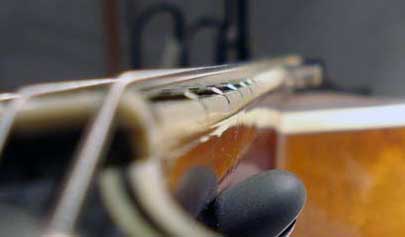


While the truss rod can be adjusted for some bow in the neck, a serious bow might indicate a problem that can’t be fixed. Learn how to adjust the truss rod in this guide.
Key point: always be on the lookout for potential problems. Even if a slight crack or damage doesn’t seem bad now, it could cause problems later on.
What to Play When Testing a Guitar
When you go to test out a guitar, what you play can help you figure out if the guitar is right for you.
So what should you play in a guitar store to test out a guitar?
There are two things you should play to test out a guitar. First, play songs, riffs, and licks you usually play to get an overall feel for the guitar. Second, play specific things to test the guitar’s intonation, fret wear, and hardware.
Let’s go through both of these two things so you know why you should play them and what to look for when testing a guitar.
Songs or Riffs You Usually Play
When you go to a guitar store or meet privately to potentially buy a guitar, it’s not the time to show off your skills or try and impress anybody.
Don’t worry about what other people might think about your playing style or skills. It doesn’t matter what other people think. Your only job is to test the guitar out.
I recommend spending a few minutes playing song parts that you already know really well. This lets you focus on how the guitar plays instead of worrying about what the next note or chord should be.
If you play a riff that you’ve played thousands of times before, you’ll be able to tell if something isn’t quite right with the guitar.
If you hear some fret buzzing, or the notes sound slightly out-of-tune, you’re far more likely to notice these issues when you play something you’ve already memorized.
The other reason to play song parts that you usually play is that that’s the type of stuff you’ll be playing in the future. So you may as well test the guitar with parts you enjoy playing.
Don’t go to a guitar store and try to play blues just because that’s what the person before you was playing. Play the music you normally play.
Note: I really want to emphasize that you should test the guitar playing music you normally play. This means if you normally play with a capo, bring a capo with you. If you normally play in Drop-D tuning, put the guitar in Drop-D. It’s important that you test the guitar using music you know really well.
If you’re a beginner or intermediate guitarist, you might feel a bit intimidated to test out a guitar. But don’t worry about other people and what they might think of your playing. Just play what you know best.
Before you go to test out the guitar, decide on a handful of riffs, licks, or anything else you will play to test the guitar. This will help you avoid getting stuck for ideas on what to play.
Play to Test the Guitar
After you have spent a few minutes jamming with song parts that you know really well, the other thing to play is specific tests to check different aspects of the guitar.
These tests include checking the guitar’s intonation, looking for uneven frets, and testing out the hardware.
In the checklist later in this guide, I’ve included Guitar TAB of what to play to test all of these things.
The main point to remember is that most of your time should be spent jamming with parts you normally play to get a feel for the guitar.
Then if it feels nice to play, run through the tests covered in the checklist to make sure there are no issues.
Guitar Test Checklist
The following checklist can be used for testing any guitar. Whether you’re looking at buying an electric or acoustic guitar, run through this test to make sure everything is okay before you decide on buying it.
If you find any issues, it doesn’t necessarily mean you shouldn’t buy the guitar. But you do need to consider whether the issues can be fixed or repaired. Keep this in mind when deciding on how much to spend on the guitar.
1. Visually inspect the guitar for damage
Pick up the guitar and look over it for any damage, wear and tear, or cosmetic blemishes.
Even new guitars can sometimes get damaged, so avoid a headache and check for damages before you test it.


Check the guitar neck joint for cracks, the headstock for structural issues or dents, and check all of the hardware sits firmly on the guitar.
Look for any rusting or corrosion in the bridge, pickups, or headstock hardware.
2. Test the electronics
If you’re testing an electric guitar or an acoustic guitar with an inbuilt pickup, plug the guitar in and make sure everything works as it should.
If you’re testing an acoustic guitar with an inbuilt pickup or an electric guitar with active pickups, bring a 9V battery with you just in case the one in the guitar is flat.
Check all of these items with the guitar plugged in and a chord ringing out:
- Roll the volume knob up and down a few times
- Roll the tone knob back and forth
- Change between every pickup position
- Lightly jiggle the guitar lead in the jack
- Test any push-pull knobs
- Test any onboard tuners, EQ sliders, gain knobs (acoustic)
- Listen for any volume drops or loud pops as you switch between pickups
Listen for cracking in the signal as you plug the guitar in, turn the knobs, or adjust the pickup selector.


Don’t worry about playing anything at this stage, just focus on making sure all the electronics works.
3. Detune, then re-tune the guitar
Slightly detune the guitar, then use your tuner or tuner app to re-tune the guitar.
This is so you can check the quality of the tuning heads as well as check the tuning stability.


Listen for any slips or jumps when you re-tune the guitar. This can indicate poor quality tuning heads or other issues.
Before you finish testing the guitar, re-check the tuning to see how well it has held tune.
4. Play songs you know well
Play through some songs or parts you know really well and just get a feel for the guitar.
If you usually play standing up, bring a guitar strap to test it out. If you usually play sitting down, sit down to test the guitar.
Think about how the guitar feels to play comfort-wise and pay attention to any small issues you notice.
Run through the typical stuff you normally play and think about how this guitar sounds and feels compared to your usual guitar.
5. Test the intonation
Grab your guitar tuner or tuner app to test the intonation.
Play the 12th fret harmonic on each string, then compare that pitch on your tuner to the pitch of the fretted 12th fret note.
Here’s a Guitar TAB of what to play for this test:


If the intonation is out, check the bridge to make sure there’s enough room to adjust the saddle in either direction (if possible).
Find out more about intonation in this guide.
6. Check every fret for buzzing
Play every fretted note position on every string and listen for any buzzing or muted sounds.
If you are testing an electric guitar, test using a clean tone without any effects to make sure it doesn’t mask any fret buzzing.
You can do this one string at a time or one position at a time as shown in the below Guitar TAB:
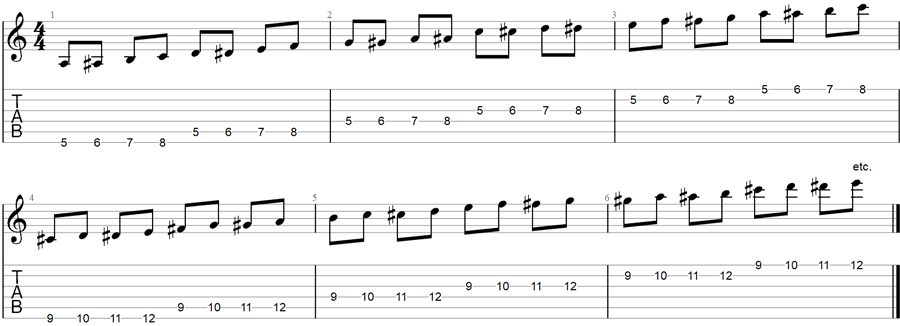

Start at the first fret, then follow the above pattern to work your way up the entire fretboard. The positions where you might encounter fret buzzing depends on the playing style of the guitar’s owner. For example, if they play a lot of lead guitar, there will be more fret wear on the upper frets.
If you play a note and you hear a buzzing sound or it sounds slightly muted, it’s a sign that the fret isn’t level.
Check for fret wear by pushing the string to the side.



If you see worn out frets, take note of how much they have worn down to decide whether you want to try and fix it or not.
Even if a worn down fret doesn’t cause fret buzzing now, it may happen soon in the future depending on your own playing style.
7. Check the action height
When you play the guitar, you’ll get a sense of whether the action height is set to your liking or not.
If it isn’t set to your liking, it doesn’t automatically mean the guitar isn’t for you.
You need to consider whether the action can be adjusted to suit your playing style.
On an electric guitar, check the bridge saddles and see if there is room for adjustment. For example, the below bridge has plenty of room to either raise or lower the action.
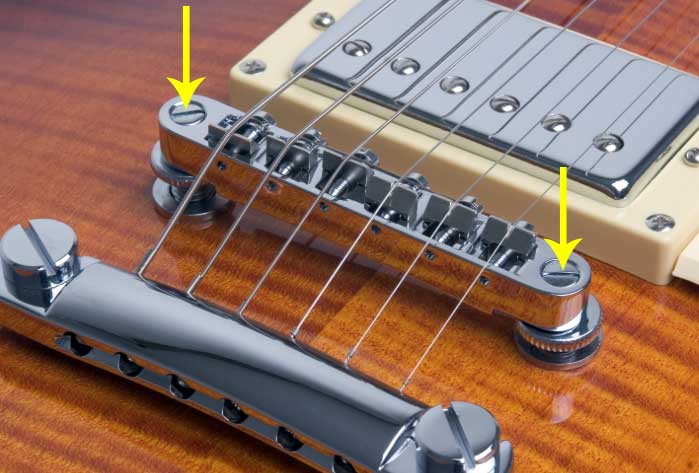

If you’re testing an acoustic guitar, take a look at the bridge saddle and whether you can file it down or replace it with a higher one.
For example, the below bridge saddle is quite high and if you wanted to lower the action, it would be a simple fix to file it down.
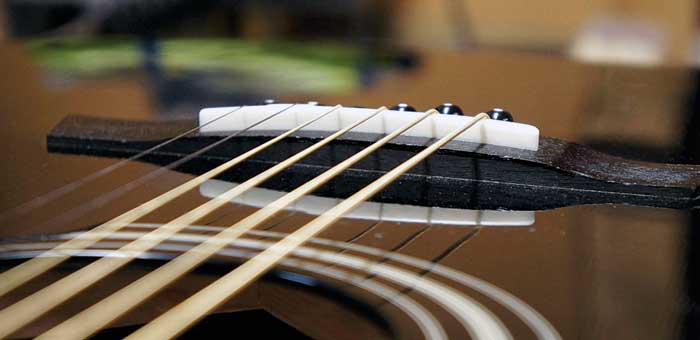

Action height is important to consider when testing a guitar, but don’t immediately give up on a guitar if the action hasn’t been adjusted perfectly to your preferred position.
8. Check for neck warping issues
Look down both sides of the neck from the headstock to check how straight the neck is set.



A slight bow is expected depending on how the owner prefers his action height.
The main thing you’re looking for here is any signs of warping. If you notice the bow on one side of the fretboard doesn’t match the bow on the other side, that’s a big red flag to consider.
If something doesn’t look right, ask if you can adjust the truss rod. If you’re allowed to make a small adjustment, take notice of how smoothly the truss rod can be adjusted. Look out for any signs of resistance.
9. Decide on Price
Once you have gone through all of your tests, you can decide how much this guitar is worth to you.
For example, if there are some problems such as a scratchy sounding volume knob or a damaged nut, consider the time and cost you need to invest to fix those issues. Adjust the price you’re willing to pay for the guitar to fix all issues you find.
Serious wear and tear or issues may be enough for you to not buy the guitar. Don’t be afraid to walk away from what might seem like a good deal if you’re unsure whether you can properly address any issues.
One point thing to always keep in mind is whether the deal sounds too good to be true. There have been countless guitarists over the years who have been sucked into spending way too much money on either a fake guitar or a guitar with major issues.
Do your research before you check out a guitar and the more a guitar is worth, the more research and testing you should put in before you commit to buying it.
What to Do After Buying a Guitar
After you buy a guitar, you should set up it to suit your own playing style. Adjust the truss rod, fix any intonation issues, and adjust the action height to suit you.
Even a brand new guitar may not be set up perfectly to suit your playing style, so don’t be afraid to make minor adjustments straight away.
If you’re buying a second-hand guitar, take the strings off and give it a thorough clean. Wipe away any gunk of buildup on the fretboard and clean everything.
Putting a brand new set of strings will help your guitar need and sound so much better.
Put some time into playing it and if you notice any problems, take it back to the store (or contact the seller) asap. The longer you leave it, the less likely you’ll get a positive response if you change your mind or you find an issue you didn’t notice during testing.
Guitar Testing Tips
If you follow the above advice, you’ll have a good idea of the pros and cons of the guitar you’re testing.
Here are some extra tips to help you get the most out of any test you do with a guitar:
Bring an Experienced Guitarist
If you’re not confident in your ability to identify possible issues with the guitar, bring somebody who can help you.
Keep in mind that a lot of guitarists have different ideas on what makes a good guitar, so you’re not asking this person for their advice on whether they think you should buy the guitar. You’re only asking them to point out possible issues for you to consider.
It doesn’t matter if the friend you bring thinks the guitar feels great to play – if you don’t like playing it, it isn’t great.
If you bring somebody with you, simply ask them to run through the checklist covered in this guide.
Do Your Research
The more you know about a guitar before you go to test it, the more likely you’ll make the right decision.
Even guitar salespeople in stores can get details wrong about a guitar, so try to research the guitar as much as possible before you go to try it out.
Look up the model number on official guitar websites, then research that model in guitar forums and groups for possible issues to look for.
If you’re buying a second-hand guitar, research the serial and model number before meeting with the seller. Don’t rely on any information the seller tells you – even if they seem honest.
Avoid Impulse Buying
Sometimes you really want a specific guitar – until that feeling passes and you really want a different guitar.
I can’t tell you how many students I’ve had over the years who told me one week how they were going to buy a guitar that they really want, then a month or two later to tell me they’re trading that guitar in for something else.
Gear Acquisition Syndrome (GAS) is real and impacts a lot of guitarists. If you ever find yourself with a sudden urge to buy a specific guitar, sit on it for a bit.
Just wait a few weeks and see if you still have that same urge.
But what if you miss out on the sale?!?
There’s always another guitar out there for you. There have been many times when I was convinced that I needed a specific type of guitar, only for that feeling to pass within a month.
Testing a Guitar FAQs
Here are some common questions you might have about testing a guitar to buy.
How Do You Check if a Guitar is in Good Condition?
To check if a guitar is in good condition, visually inspect the entire guitar looking for damage, wear and tear, or other issues. Take a close look at the frets for signs of wear.
What ‘good condition’ means depends on the age of the guitar, so learn as much as you can about the guitar before you check it out.
How Do I Know if a Guitar is Fake?
You can tell if a guitar is fake by learning as much as you can about what the real guitar should look like. Compare photos of real guitars and look for any discrepancies in the hardware used, logo position, or finish quality.
Also, check the model number and serial number against a reference to make sure the model number matches the guitar you’re checking and that the serial number isn’t a known fake.
Check the quality of the fret edges and finish and think whether it matches the price of the guitar. A guitar with roughly finished frets is usually a clear sign of a fake.
The more you know about the features and style of the real guitar, the less likely you’ll be fooled by a fake.
How Can You Tell if a Guitar is Used?
You can usually tell if a guitar is used from slight cosmetic blemishes on the body. Look for dust buildup under the strings, fret wear, and scratches on the front or back of the guitar body.
Some guitar owners are rough on their guitars while other owners can keep them in pristine condition for years.
Should You Buy a Used Guitar?
Buying a used guitar is a great way to save money while still getting a good quality guitar. If you know what to check, you can get yourself a high-quality guitar for a serious discount compared to a new guitar.
Find out the pros and cons of buying a new or used guitar in this guide.
What Should I Know Before Buying a Guitar?
Before you buy a guitar, you should know what type of guitar suits you best and why. Research different makes and models before you go to a guitar store so you know what other options you might want to consider.
You should also have a good general idea of your budget level and how much various models are worth new or used.
If you’re new to guitar, you should also consider any extra costs such as buying an amp.
How Much Should a Beginner Spend on a Guitar?
A beginner should spend whatever they feel comfortable paying for a guitar. While some people will say you should only buy a guitar worth at least $X, that’s not helpful advice.
There are some $200 guitars that play perfectly fine, while there are some $800 guitars that feel horrible to play.
How much you should spend should depend on what type of guitar you want and how much you’re happy to spend. There’s nothing wrong with starting on a budget-level guitar and there’s nothing wrong with starting on a high-end guitar – it all depends on what you feel comfortable spending.
What are Good Songs to Test a Guitar?
The best songs to play to test out a guitar are songs you know really well. Play songs that you have already memorized so you can focus your attention on how comfortable the guitar feels to play and how good it sounds.
Don’t be tricked into thinking you need to play certain things to test a guitar out. You’re not there to impress anybody – you’re there to see if a guitar is right for you.
What to Play in a Guitar Store?
When testing a guitar in a guitar store, play what you would normally play at home. Don’t try to impress anybody or show off – just play what feels natural to you.
Playing what you normally play will give you the best sense of whether the guitar is right for you or not.
Testing the guitar is only one part of the buying process. Read this guide on buying a used guitar for more advice on where to look for used guitars, how to negotiate a better price, and how to avoid getting scammed.
If you’re not sure what type of guitar to buy, read through this guide on types of guitars for a thorough overview of different options to consider.
